Many modern traditions have their roots in Norse Viking culture. Select one below to learn more!
- Christmas Tree
- Feasting
- Evergreen Decorations
- Garland
- Gift-Giving
- Mistletoe
- Naughty and Nice List
- Pajamas on Christmas Eve
- Reindeer
- Snowmen
- Stockings
- Twelve Days of Christmas
- Wassailing / Caroling
- Wreaths
- Yule Goat
- Yule Log
Christmas Tree

In Norse and Viking cultures, the winter solstice, known as Yule, marked the longest night of the year and the return of longer days. During Yule festivities, evergreen trees and plants like holly and mistletoe were used to symbolize the persistence of life in winter's darkness. These decorations represented hope and the promise of the sun's return.
The Norse also revered Yggdrasil, the World Tree, as a symbol of interconnectedness and the cycle of life, death, and rebirth. This concept of a sacred tree may have influenced the use of trees in later traditions.
In Germany, influenced by Norse and Viking customs, there was a tradition of bringing evergreen trees indoors and decorating them during the Christmas season. This practice began as early as the 16th century and eventually spread throughout Europe.
During the Protestant Reformation, legend has it that Martin Luther, a key figure, was inspired by stars shining through tree branches. This led him to bring an evergreen tree into his home, decorating it with candles to replicate a starry night. This contributed to the use of Christmas trees in Christian households.
Queen Victoria's marriage to Prince Albert, of German descent, brought the Christmas tree tradition to England in the 19th century. A famous illustration of the royal family with a decorated tree popularized the custom in Victorian England and beyond.
German immigrants introduced the Christmas tree tradition to the United States in the 18th and 19th centuries. It gained popularity and became a central element of American Christmas celebrations.
Today, the Christmas tree symbolizes hope, light, and the enduring spirit of the holiday season, evolving from its Norse and Viking roots into a cherished tradition worldwide.
Mistletoe
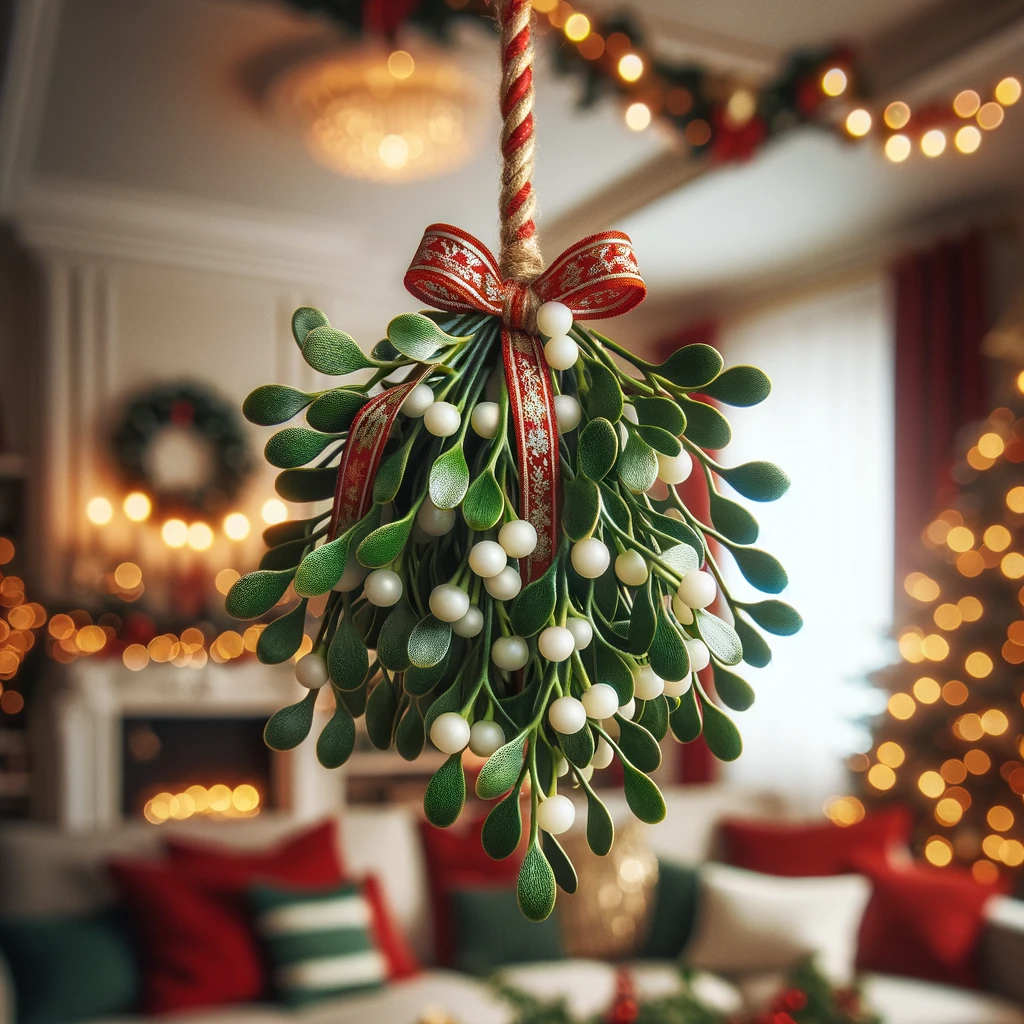
The tradition of kissing under the mistletoe, which has become a popular Christmas custom, has its roots in Viking and Norse mythology. Here's a more detailed explanation of how this tradition is derived from Viking traditions:
- The Myth of Balder and Mistletoe: In Norse mythology, Balder was a beloved god associated with light, purity, and goodness. His mother, Frigg (Frigga), the queen of the gods, had a premonition that Balder's life was in danger. To protect him, she went to great lengths to secure promises from all living beings and objects that they would not harm Balder. However, she overlooked mistletoe, deeming it harmless.
- oki's Trickery: Loki, the trickster god in Norse mythology, noticed Frigg's oversight and decided to exploit it. He fashioned a dart or arrow using mistletoe and tricked Balder's blind brother, Hod (Hoor), into throwing it at Balder during a game in which the gods were demonstrating Balder's invincibility. Tragically, the mistletoe dart pierced Balder, leading to his death.
- Transformation of Symbolism: The death of Balder with mistletoe became a symbol of sorrow and tragedy in Norse mythology. It represented the vulnerability of even the most beloved and invincible figures. However, it also carried a message of hope and rebirth, as Balder was expected to return from the underworld.
- Integration into Christmas Traditions: Over time, as Christianity spread and absorbed various pagan customs and traditions, the symbolism of mistletoe transformed. The sorrowful association with Balder's death evolved into a more joyful and festive symbol. Mistletoe began to represent love, goodwill, and the promise of new beginnings.
- The Kissing Tradition: The practice of hanging mistletoe as a decoration during Christmas and exchanging kisses beneath it likely emerged from the Norse roots. Kissing under the mistletoe symbolizes affection, love, and the idea that anyone standing beneath it is granted a moment of goodwill and harmony. It carries a spirit of togetherness and festivity.
- Today, the tradition of kissing under the mistletoe is a cherished part of Christmas celebrations in many cultures. While its origins lie in Viking and Norse mythology, it has been embraced as a joyful and romantic custom associated with the holiday season, embodying the spirit of love and unity.
Christmas Wreath
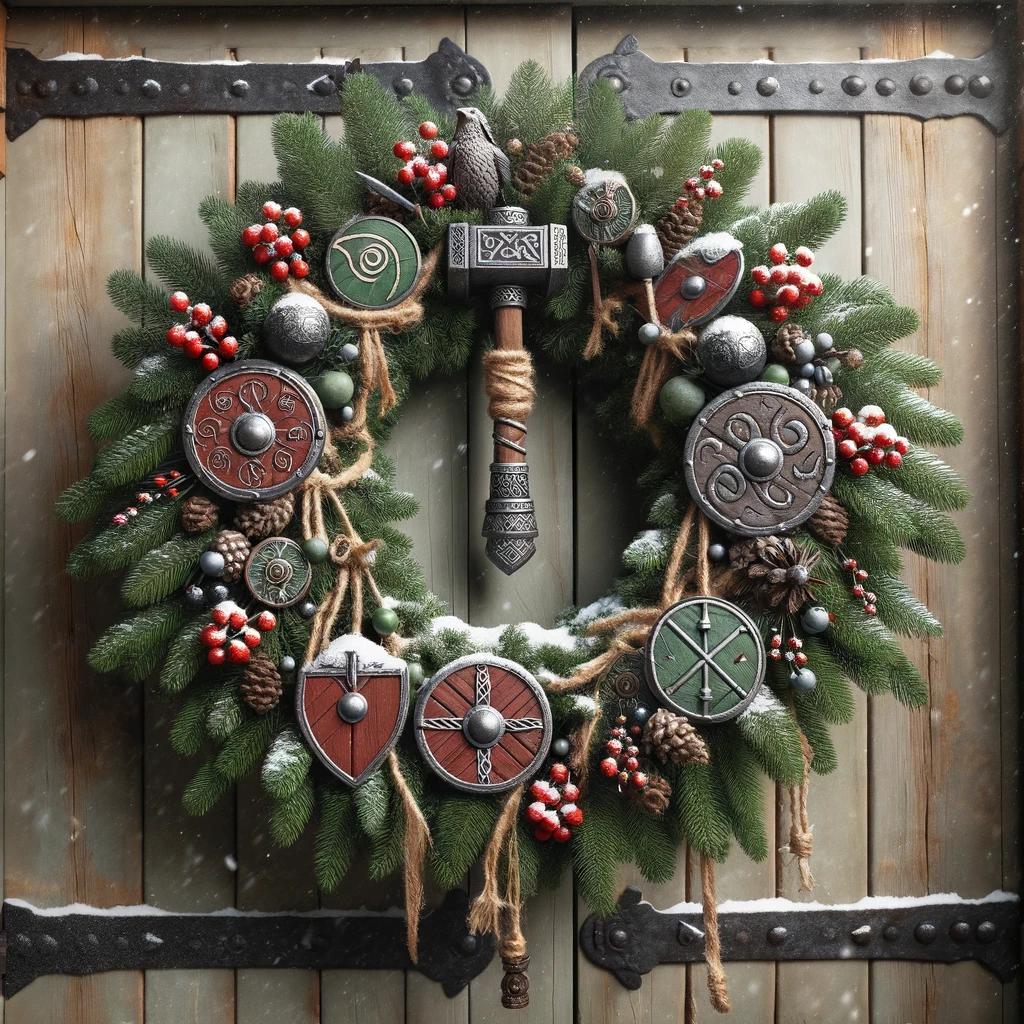
In Norse and Viking cultures, the winter solstice, known as Yule, was a time of celebration and hope for the return of the sun's warmth. Evergreen plants like holly and ivy were revered for their ability to stay green during the harsh winter months, symbolizing life's persistence in the face of darkness.
Wreaths made from these evergreen branches were crafted and hung as decorations during Yule festivities. The circular shape of the wreath represented the cyclical nature of life, death, and rebirth, as well as the continuity of nature's cycles.
During Yule celebrations, wreaths were often adorned with candles, representing the return of the sun and the triumph of light over darkness. This practice symbolized hope and the promise of brighter days to come.
As Christianity spread and absorbed some of these pagan traditions, the use of wreaths continued but took on new meanings. The circular shape of the wreath came to symbolize eternity and the unending love of God.
In the 16th century, Lutherans in Germany adopted the Advent wreath, a wreath with four candles, each representing one of the four Sundays leading up to Christmas. This tradition spread throughout Europe and eventually to other parts of the world.
Today, the Christmas wreath remains a cherished symbol of hope, unity, and the enduring spirit of the holiday season, with its origins firmly rooted in the Norse and Viking traditions of Yule.

In Norse and Viking cultures, the winter solstice, known as Yule, was a time of celebration and hope for the return of the sun's warmth. Evergreen plants like holly and ivy were revered for their ability to stay green during the harsh winter months, symbolizing life's persistence in the face of darkness.
Wreaths made from these evergreen branches were crafted and hung as decorations during Yule festivities. The circular shape of the wreath represented the cyclical nature of life, death, and rebirth, as well as the continuity of nature's cycles.
During Yule celebrations, wreaths were often adorned with candles, representing the return of the sun and the triumph of light over darkness. This practice symbolized hope and the promise of brighter days to come.
As Christianity spread and absorbed some of these pagan traditions, the use of wreaths continued but took on new meanings. The circular shape of the wreath came to symbolize eternity and the unending love of God.
In the 16th century, Lutherans in Germany adopted the Advent wreath, a wreath with four candles, each representing one of the four Sundays leading up to Christmas. This tradition spread throughout Europe and eventually to other parts of the world.
Today, the Christmas wreath remains a cherished symbol of hope, unity, and the enduring spirit of the holiday season, with its origins firmly rooted in the Norse and Viking traditions of Yule.
Christmas Stockings
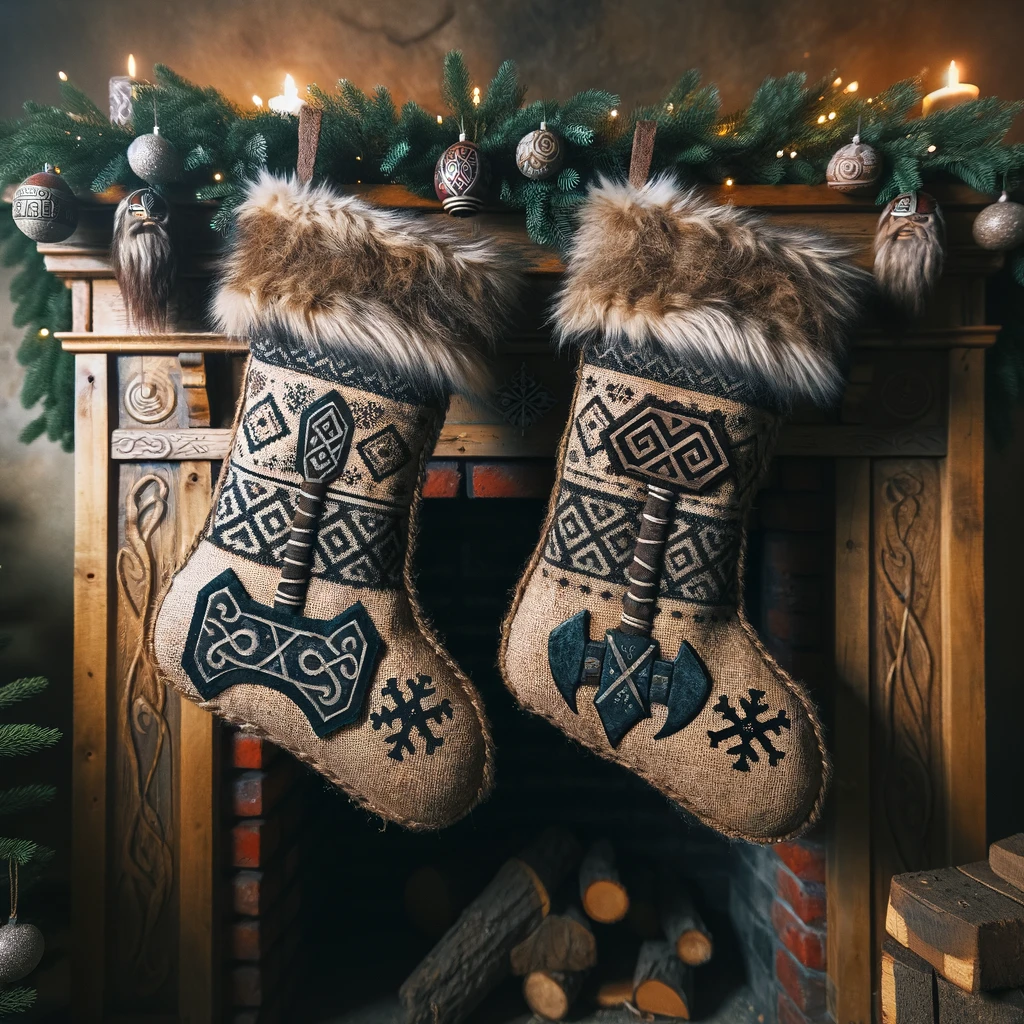
In Norse and Viking mythology, there was a tradition of hanging socks or footwear by the fireplace during the winter solstice celebrations, particularly during the festival of Yule. This tradition had its roots in the belief that the god Odin, known for his wisdom and gift-giving, would visit homes during Yule to bring blessings and gifts to the inhabitants.
Odin's association with socks or boots stems from the myth of Sleipnir, his eight-legged horse. According to the legend, Odin would ride Sleipnir through the night sky on his gift-giving journeys. People would leave hay and treats in their boots as offerings to Odin's horse, hoping for blessings in return.
Over time, as Christianity spread and absorbed some of these pagan customs, the tradition of hanging stockings by the fireplace persisted but evolved. In many cultures, stockings replaced boots, and children began to hang them in the hope of receiving gifts from Santa Claus, who took on some attributes of Odin.
The idea of Santa Claus or Father Christmas coming down the chimney and filling stockings with presents became a popular part of Christmas folklore. The tradition of hanging stockings by the fireplace on Christmas Eve continues to be a cherished practice in many households today.
So, when you hang your stockings by the fireplace during the holiday season, you're participating in a tradition with deep Norse and Viking roots that has been adapted and embraced in modern Christmas celebrations.
Christmas Eve Pajamas

The tradition of wearing new pajamas on Christmas Eve has a delightful connection to Norse and Viking traditions, including the mischievous Jólakötturinn (Jola) the Yule Cat. In Norse mythology, Yule, the winter solstice festival, was a time of great celebration and feasting. It was believed that during Yule, spirits and supernatural beings were more active and present.
To protect themselves from mischievous spirits like Jola and to ensure a peaceful night's sleep, Norse families would don new sets of clothing, including cozy pajamas, on Yule Eve. These special garments were not only comfortable but also thought to bring luck and protection from any otherworldly disturbances.
As Christmas traditions evolved and merged with Norse customs, the practice of donning fresh pajamas on Christmas Eve persisted. It became a cherished ritual for families, especially for children eagerly awaiting the arrival of Santa Claus and keeping an eye out for Jola the Yule Cat.
Today, many families across the world continue the tradition of giving and wearing new pajamas on Christmas Eve. It adds an extra layer of excitement and comfort to the holiday season, ensuring a peaceful night's sleep and creating fond memories for all.
Yule Log
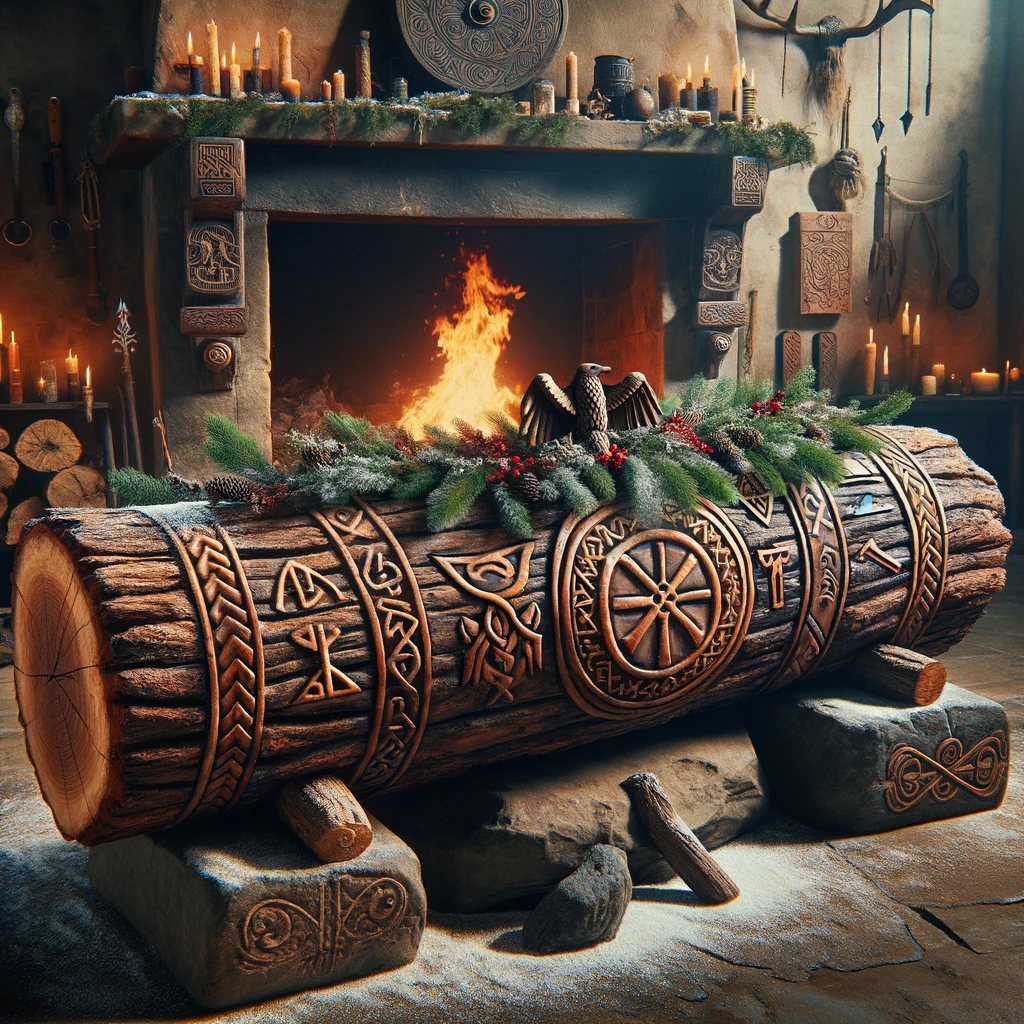
The tradition of the Yule Log has deep roots in Norse and Viking traditions, particularly during the celebration of Yule, the winter solstice. Yule was a time of great importance in these cultures, marking the rebirth of the sun and the gradual return of longer days.
One of the central elements of Yule celebrations was the burning of a massive log, known as the Yule Log. This log was carefully selected and often decorated with evergreen branches, holly, and mistletoe. The lighting of the Yule Log symbolized the triumph of light over darkness and the renewal of life as the days began to lengthen.
The Norse also believed that the Yule Log had protective and purifying qualities. It was thought to ward off malevolent spirits and bring good fortune to the household. As the Yule Log burned, families would gather around the hearth, sharing stories, feasting, and enjoying the warmth of the fire.
Over time, as Norse traditions merged with Christian celebrations of Christmas, the Yule Log transformed into a symbol of the holiday season. While the burning of a Yule Log has become less common, the tradition lives on in the form of Yule Log cakes, which are often enjoyed as a festive dessert during Christmas celebrations.
Gift-Giving
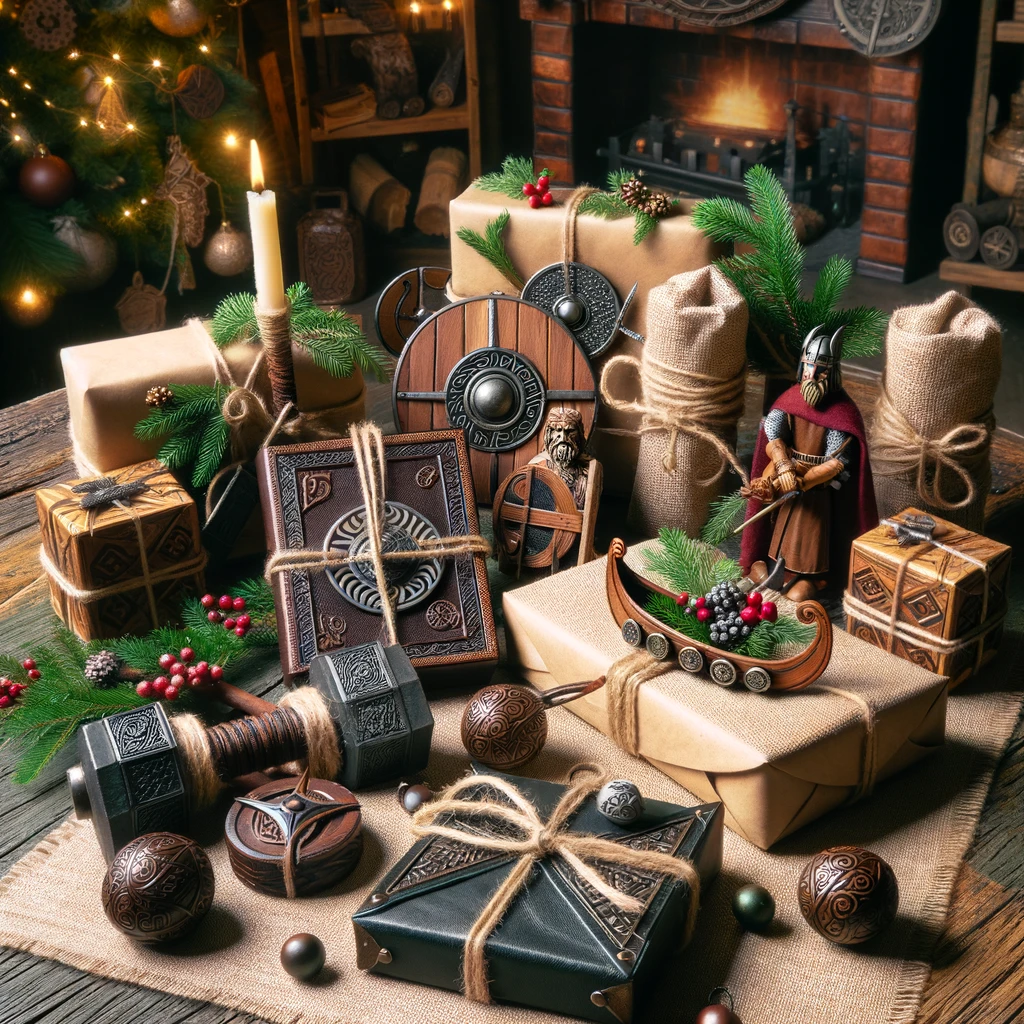
The tradition of gift-giving during Christmas has its roots in the spirit of generosity and celebration found in Norse and Viking cultures, particularly during the Yule festival.
Yule, the winter solstice, was a time of great importance in Norse mythology. It marked the darkest period of the year when the days were shortest, and the nights were longest. However, it was also a time of hope and anticipation, as it symbolized the rebirth of the sun and the return of longer days.
During Yule, the Norse and Vikings exchanged gifts as a way to celebrate the season and show their love and appreciation for one another. These gifts often included handmade crafts, food, and tokens of good fortune.
As the centuries passed and Christmas merged with Norse traditions, the act of giving and receiving gifts became a central part of the holiday season. It evolved to include the tradition of Santa Claus, who embodies the spirit of giving and spreads joy by delivering presents to children around the world.
Today, gift-giving during Christmas serves as a reminder of the enduring values of love, compassion, and togetherness, echoing the ancient traditions of the Norse and Vikings.
Christmas Dinner / Feasting
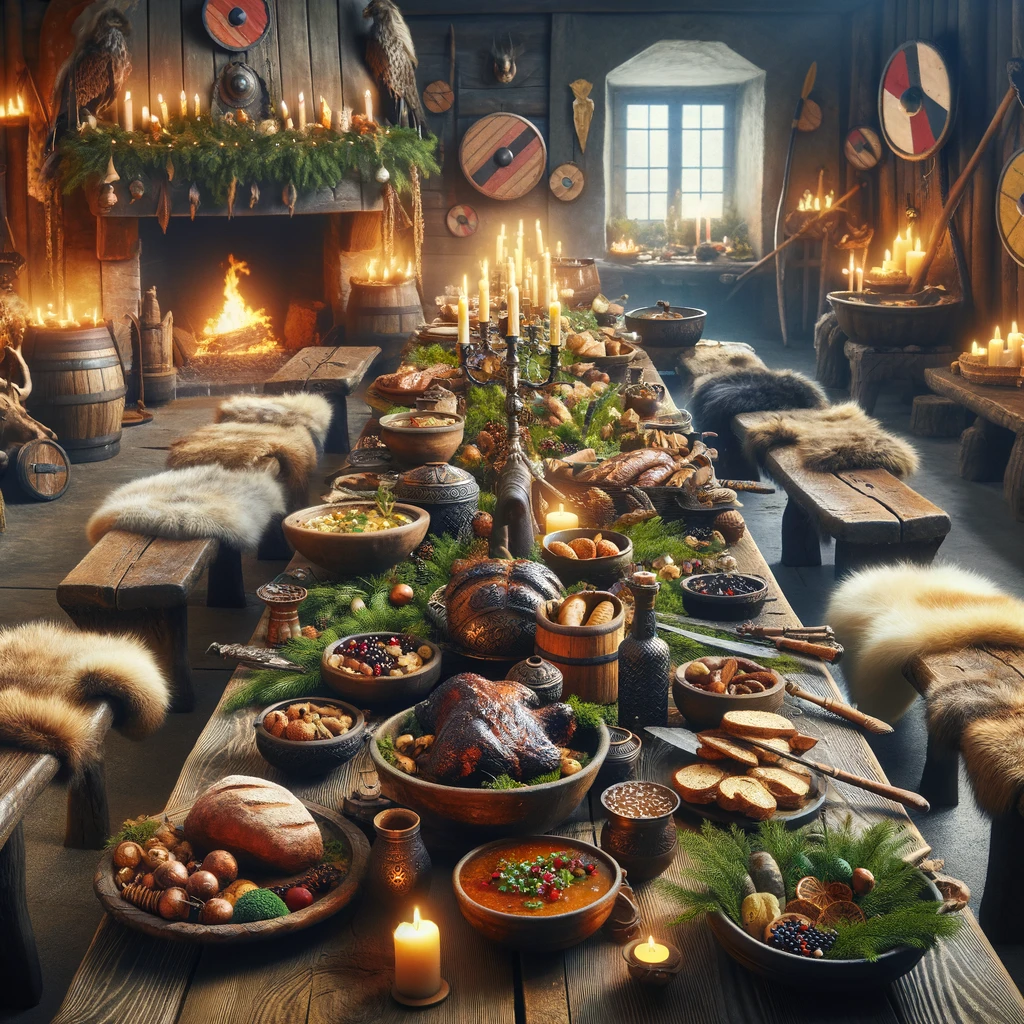
The tradition of gathering for a festive Christmas dinner or feast has its origins in the rich feasting customs of Norse and Viking cultures, particularly during the Yule festival.
Yule, the winter solstice, was a significant event in Norse mythology as it marked the darkest and longest night of the year. However, it was also a time of great hope and celebration, symbolizing the return of longer days and the promise of renewed life.
During Yule, Norse and Vikings would come together to feast and celebrate the season. This feasting was an expression of gratitude for the past year's harvest and a way to share warmth, companionship, and goodwill with loved ones. The festive meal often included a variety of foods, including meats, fruits, bread, and ale.
As Christmas traditions evolved and merged with Norse customs, the practice of gathering for a bountiful Christmas dinner remained. It became an integral part of the holiday season, symbolizing unity, abundance, and the joy of coming together with family and friends.
Today, Christmas dinner and feasting continue to be cherished traditions, with families and communities worldwide enjoying hearty meals and merry gatherings during the holiday season.
Wassailing (Caroling)
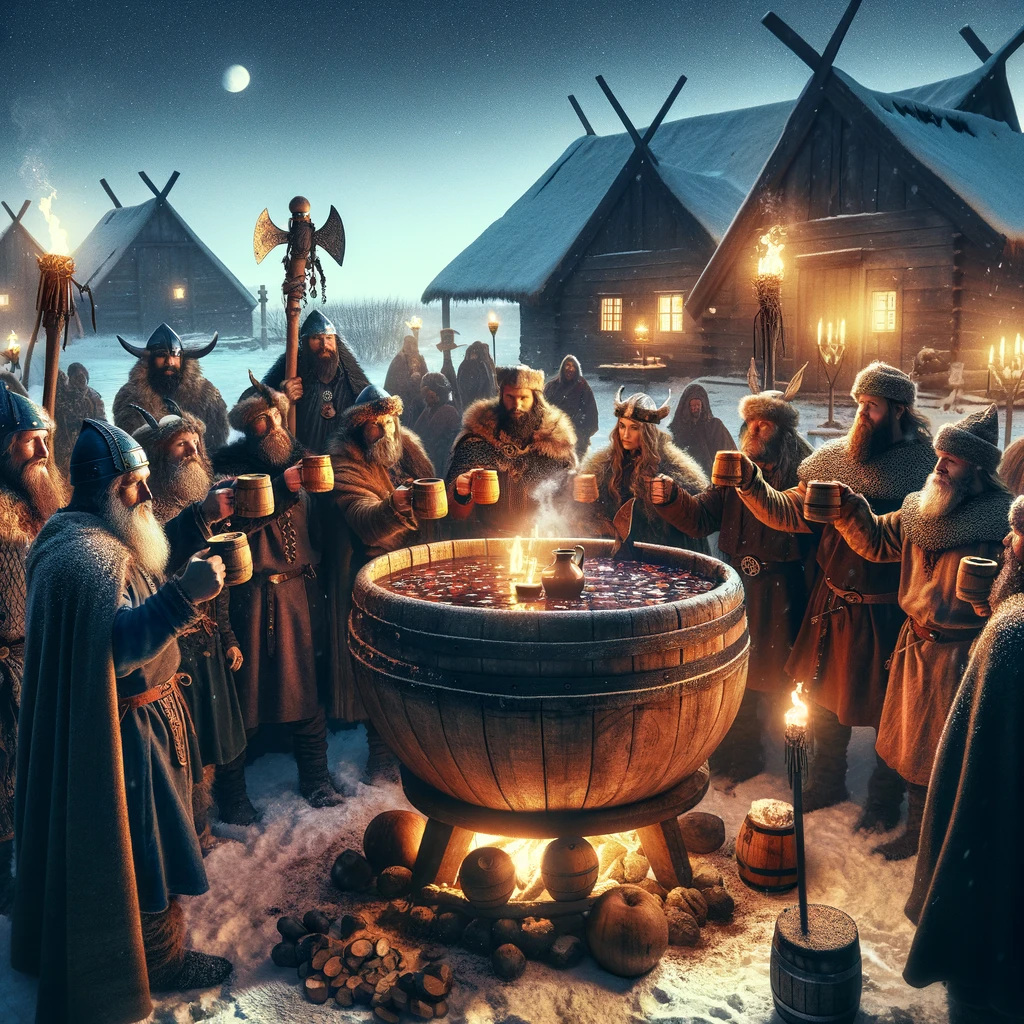
Wassailing, a joyful and communal Christmas tradition, has its roots in the ancient customs of Norse and Viking cultures. The term "wassail" itself comes from the Old Norse phrase "ves heill," which means "be in good health" or "cheers to you."
In Norse and Viking societies, the Yule festival was a time of celebration and feasting during the winter solstice. It was believed that during Yule, spirits and supernatural beings were more active and present. To ensure a bountiful harvest in the coming year and to ward off malevolent spirits, the Norse would go "wassailing" their apple orchards and other fruit trees.
They would sing songs, make offerings of food and drink, and even pour cider or ale onto the roots of the trees. This act of wassailing was a way to invoke blessings, good fortune, and protection for the orchards and their crops.
Over time, as Christmas traditions merged with Norse customs, wassailing became associated with the holiday season. The act of going door to door, singing carols, and sharing beverages like mulled cider or punch is a modern expression of wassailing. It represents the spirit of goodwill, unity, and sharing during Christmas festivities.
Today, wassailing continues to be a cherished Christmas tradition, bringing communities together in song and celebration to wish each other health, happiness, and good fortune for the year ahead.
Yule Goat
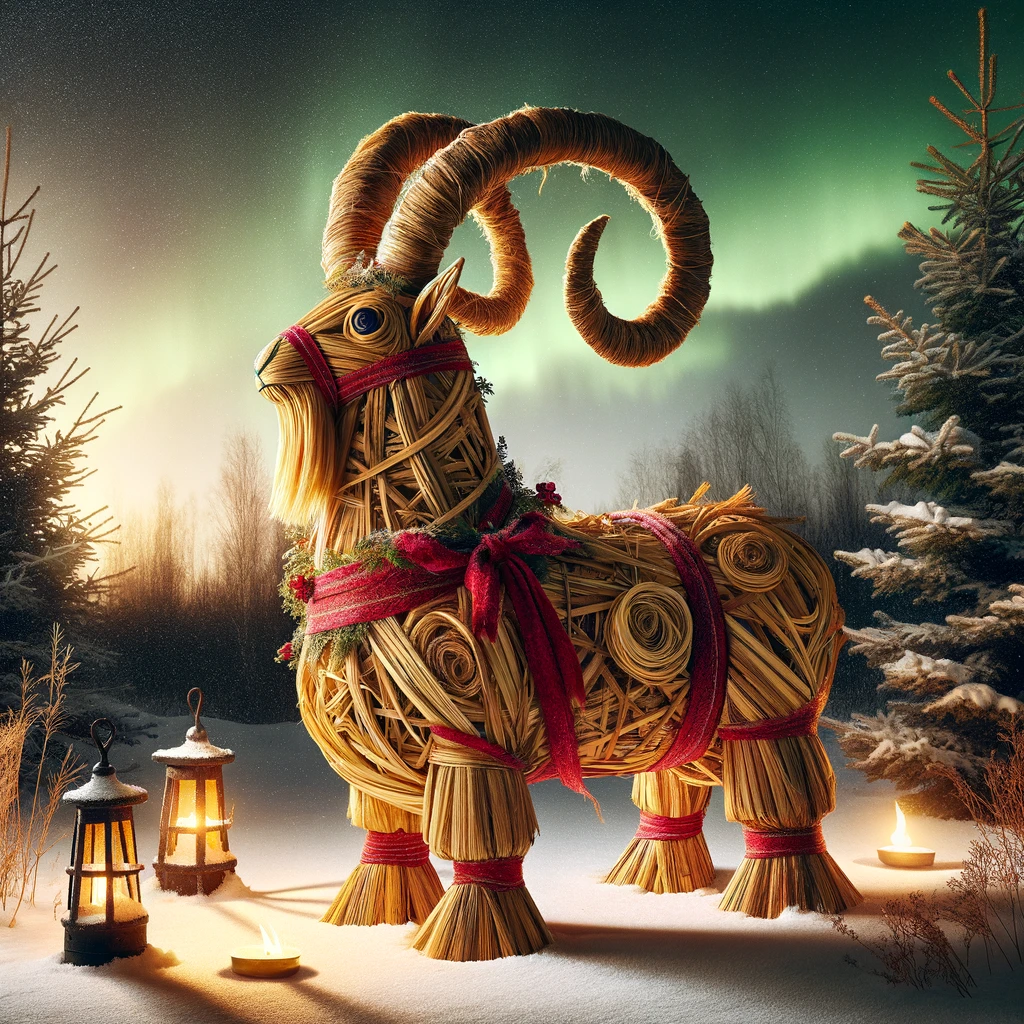
The Yule Goat, a charming and peculiar Christmas symbol, finds its origins in Norse and Viking traditions associated with the winter solstice celebration known as Yule. In the old Norse tradition, the god Thor, who rode in a chariot pulled by two magical goats, was a central figure in Yule festivities.
The connection to goats continued in Scandinavian folklore, where the Yule Goat (or "Julbock" in Swedish) was believed to be a spirit that watched over the Yule celebrations. This benevolent creature would sometimes be portrayed as a playful and mischievous figure who would visit homes to ensure the Yule preparations were in order.
Over time, the Yule Goat became associated with gift-giving traditions. In some Scandinavian cultures, it was believed that the Yule Goat would deliver presents to children. In other regions, the Yule Goat's role evolved into that of a benevolent gift-giver similar to Santa Claus.
Today, the Yule Goat takes various forms in Christmas decorations, from straw ornaments to festive costumes. In some Scandinavian countries, a person dressed as the Yule Goat may visit homes during the holiday season, bringing gifts and spreading joy.
The Yule Goat is a delightful reminder of the rich Norse heritage that continues to influence modern Christmas celebrations.
Evergreen Decorations
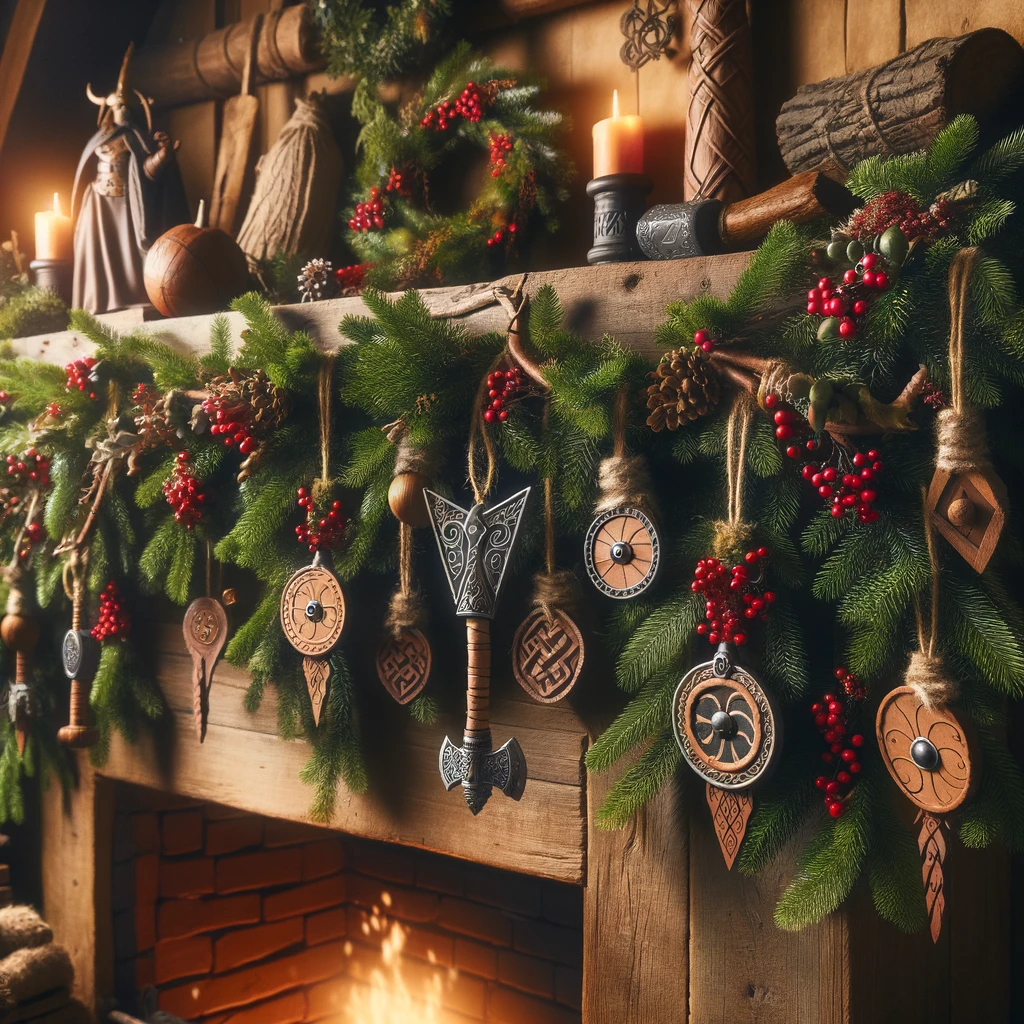
In Norse and Viking cultures, the winter solstice, known as Yule, marked the longest night of the year and the return of longer days. During Yule festivities, evergreen trees and plants like holly and mistletoe were used to symbolize the persistence of life in winter's darkness. These decorations represented hope and the promise of the sun's return.
The Norse also revered Yggdrasil, the World Tree, as a symbol of interconnectedness and the cycle of life, death, and rebirth. This concept of a sacred tree may have influenced the use of trees and evergreen decorations in later traditions.
As time passed and Yule traditions merged with Christmas celebrations, the use of evergreen decorations became a prominent feature of the holiday season. Christmas trees adorned with ornaments and lights, wreaths made of evergreen branches, and the custom of hanging mistletoe all carry the legacy of Norse and Viking traditions.
Today, these evergreen decorations serve as a reminder of the enduring spirit of life and the promise of renewal, bringing warmth and festive charm to homes during the Christmas season.
Snowmen
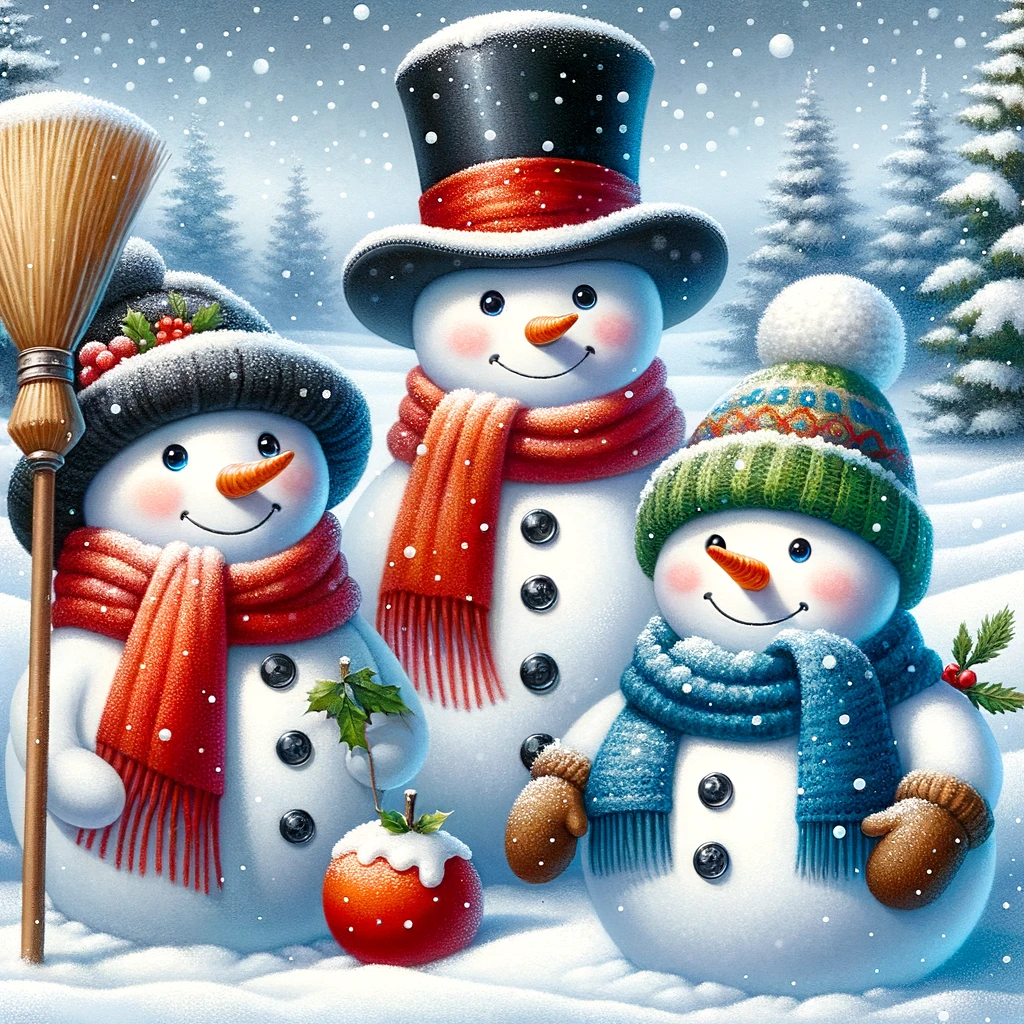
In Norse and Viking cultures, the arrival of winter was celebrated as part of the Yule festivities. The winter solstice, known as Yule, marked the longest night of the year and the return of longer days. It was a time of joy and merriment, often accompanied by feasting and outdoor activities.
One of the beloved traditions during Yule was the construction of snow sculptures, including snowmen. These snow figures were created to embody the spirit of winter and the magic of Yule. Vikings and Norse families would gather to build these whimsical snowmen as a symbol of unity and the playful side of the season.
As time passed and Yule traditions merged with Christmas celebrations, the custom of building snowmen continued. Snowmen became a delightful symbol of the holiday season, representing the joy and wonder of winter. Today, people of all ages come together to build snowmen, often adorning them with hats, scarves, and buttons, and sometimes even giving them names.
The tradition of making snowmen is a cherished part of modern Christmas celebrations, reminding us of the simple pleasures and the festive spirit that this season brings.
The Twelve Days of Christmas
The tradition of celebrating the Twelve Days of Christmas finds its roots in ancient Norse and Viking customs, particularly the festival of Yule. In Norse mythology, Yule was a significant winter solstice celebration, marking the rebirth of the sun and the gradual return of longer days.
During Yule, festivities extended for twelve days, from December 21st to January 1st, with each day having its unique significance and customs. These celebrations were a time of feasting, merrymaking, and sharing with loved ones, much like the modern Christmas season.
Over time, as Christianity spread and merged with existing traditions, the Twelve Days of Christmas became associated with the Christian holiday celebrating the birth of Jesus. Today, many people embrace the joy and togetherness of these twelve days, often exchanging gifts, hosting gatherings, and spreading goodwill, much like our festive celebrations here at the North Pole.
So, as you enjoy the holiday season, remember the ancient Norse and Viking roots of the Twelve Days of Christmas, and cherish the time spent with family and friends, just as we do at this magical time of year!